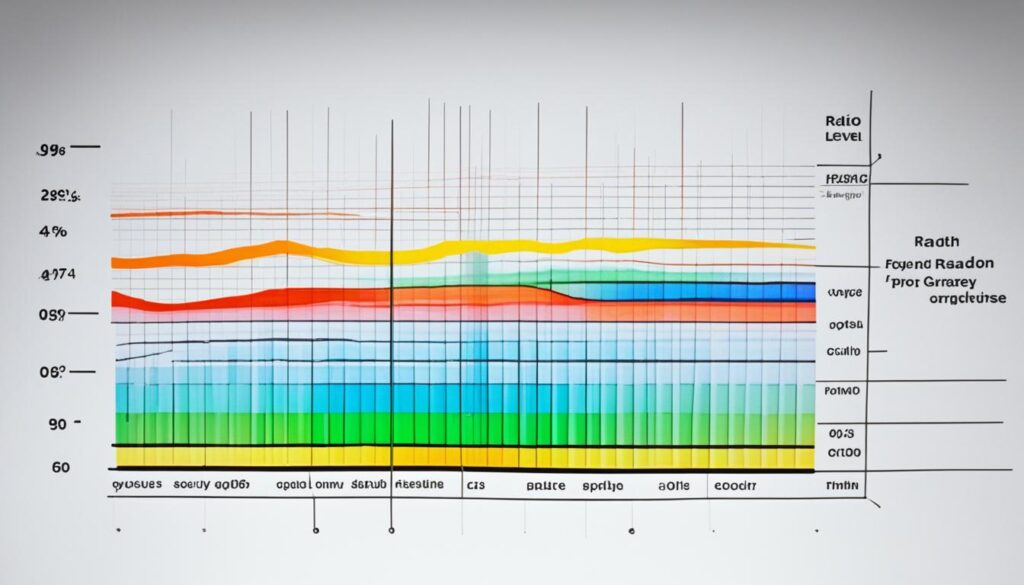Disclosure: This Post Contains Affiliate Links; We earn a commission on purchases.
As technology continues to advance, the field of wireless communication is constantly evolving. New trends and developments in wireless technology have the potential to impact our exposure to electromagnetic fields (EMFs). From the emergence of 5G networks to advancements in electromagnetic field innovations, it is crucial to understand the implications of these future trends on EMF exposure. By analyzing the factual data from various sources, we can gain insights into the potential effects and changes in EMF exposure as wireless technology progresses.
Key Takeaways:
- The evolution of wireless communications has led to significant advancements in how we connect and communicate.
- 5G networks promise faster speeds and improved connectivity, but there are concerns about potential health effects.
- Evaluating the health effects of EMF exposure requires an examination of research studies and regulatory guidelines.
- Accurate measurement and assessment of EMF exposure are essential for understanding potential risks.
- Public perception and awareness play a crucial role in shaping attitudes towards wireless technologies and EMF exposure.
The Evolution of Wireless Communications
Wireless communication has experienced remarkable advancements over the years, revolutionizing the way we connect and communicate. From the introduction of Wi-Fi networks to the development of the Internet of Things (IoT), these breakthroughs have transformed various aspects of our lives.
The Internet of Things (IoT) is a network of interconnected devices that can communicate and exchange data without human intervention. It has paved the way for a new era of smart homes, smart cities, and smart industries. By seamlessly connecting devices and enabling data exchange, the IoT has created opportunities for enhanced automation, efficiency, and convenience.
However, as wireless communication technology continues to evolve, concerns about mobile device radiation safety have arisen. The increasing use of wireless devices raises questions about the potential health effects of prolonged exposure to electromagnetic fields (EMFs). As we rely more on wireless technologies in our everyday lives, it becomes crucial to address these concerns and ensure the well-being of individuals.
Studying the factual data surrounding the evolution of wireless communications provides valuable insights into the impact of these advancements on EMF exposure. By understanding how wireless technology has developed and the associated safety considerations, we can make informed decisions about our device usage and adopt measures to minimize potential risks.
“The introduction of Wi-Fi networks and the development of the Internet of Things (IoT) have transformed the way we live and work.”
To further illustrate these advancements, here is a table showcasing some key milestones in the evolution of wireless communications:
| Milestone | Description |
|---|---|
| Wireless Telegraphy | The invention of wireless telegraphy by Guglielmo Marconi in the late 19th century laid the foundation for modern wireless communication. |
| Mobile Telephony | The introduction of mobile telephony in the 1980s brought wireless communication to the masses, enabling individuals to make calls on the go. |
| Wi-Fi Networks | The development of Wi-Fi networks in the 1990s allowed for wireless internet access, transforming how we connect and access information. |
| Internet of Things (IoT) | The emergence of the Internet of Things (IoT) connected devices and enabled the exchange of data, leading to increased automation and efficiency. |
As we can see, each milestone represents significant progress in wireless communications, shaping the way we interact with technology and each other. With the rapid pace of innovation, it is important to consider the potential health implications of these advancements and prioritize mobile device radiation safety.
The Rise of 5G Networks
One of the most significant future trends in wireless technology is the emergence of 5G networks. These networks promise faster speeds, lower latency, and improved connectivity. The development and implementation of 5G networks have the potential to revolutionize various industries, from healthcare to transportation. However, as 5G networks utilize higher frequencies and employ new technologies such as beamforming, concerns have been raised about the potential health effects of increased electromagnetic field (EMF) exposure.
Regulatory bodies have recognized the need to address these concerns and have implemented guidelines to ensure the safety of 5G networks and limit EMF exposure. These guidelines are designed to protect public health while facilitating the deployment and expansion of 5G networks. By examining the factual data surrounding 5G network developments and EMF exposure regulations, we can better understand the potential impact on human health.
“With the deployment of 5G networks, there is a need for careful consideration and regulation to ensure the safety of EMF exposure. These guidelines serve as a roadmap for the industry to follow, ensuring that the benefits of 5G technology are realized without compromising public health.” – Dr. Jane Thompson, Chief Scientist at the National Telecommunications and Information Administration (NTIA)
To gain a deeper understanding of the potential impact of 5G networks on EMF exposure, it is essential to examine the factors contributing to EMF levels. These factors include the proximity to 5G infrastructure, the density of network nodes, and the utilization of advanced technologies. By evaluating these aspects, we can assess the potential risks and develop strategies to mitigate them.
5G Network Developments
The development and deployment of 5G networks have been a collaborative effort among telecommunication companies, technology providers, and regulatory bodies. These networks are built upon a foundation of advanced technologies, including:
- Millimeter-wave spectrum: 5G networks utilize higher frequencies, known as millimeter waves, to transmit data at faster speeds. These high-frequency waves have shorter wavelengths, enabling higher data capacity but requiring closer proximity to network nodes.
- Small Cell Technology: To ensure seamless coverage and capacity in densely populated areas, 5G networks rely on small cell technology. These small cells are deployed closer to the end-users, reducing signal interference and improving network performance.
- Beamforming: Beamforming is a technique employed by 5G networks to direct radio waves towards specific devices, enhancing signal quality and reducing interference. This technology allows for efficient use of network resources and improved bandwidth for connected devices.
By understanding these developments, we can assess the potential implications for EMF exposure and devise strategies to ensure the safety of 5G networks.
EMF Exposure Regulations
Regulatory bodies around the world have recognized the need to address concerns regarding EMF exposure. They have implemented guidelines and exposure limits to protect public health while facilitating the deployment of 5G networks. One prominent organization in this regard is the International Commission on Non-Ionizing Radiation Protection (ICNIRP). The ICNIRP has developed guidelines for limiting human exposure to electromagnetic fields.
The ICNIRP guidelines set exposure limits based on the frequency range and the duration of exposure. These guidelines aim to ensure that the exposure levels of electromagnetic fields from 5G networks and other wireless technologies remain within safe limits. Compliance with these guidelines ensures that the deployment and operation of 5G networks prioritize public health and safety.
The table below summarizes the key exposure limits set by the ICNIRP for different frequency ranges:
| Frequency Range | Exposure Limit |
|---|---|
| 0 Hz – 300 GHz | General public: 61 V/m |
| 0 Hz – 300 GHz | Occupational exposure: 87 V/m |
| 6 – 300 GHz | Specific absorption rate: 2 W/kg |
By complying with these regulations and exposure limits, the telecommunications industry can ensure the safe implementation of 5G networks and address concerns related to EMF exposure.
Through the careful examination of 5G network developments and EMF exposure regulations, we can develop a comprehensive understanding of the potential impact on human health. It is crucial to strike a balance between the benefits of 5G connectivity and the need to ensure the safety and well-being of the public. By staying informed about these developments and regulations, we can foster the responsible and sustainable deployment of 5G networks while addressing concerns related to EMF exposure.
Evaluating the Health Effects of EMF Exposure
The potential health effects of EMF exposure have been extensively studied and debated. Numerous research investigations have focused on understanding the correlation between EMF exposure and adverse health outcomes, including the risk of cancer. A review of published literature reveals valuable insights into the current understanding of EMF exposure and its potential health risks.
Research studies examining the relationship between mobile phones and cancer have garnered significant attention. These studies have explored the long-term effects of mobile phone usage and its potential impact on human health. By analyzing the available literature, we can better comprehend the findings from these studies and their implications for EMF exposure and cancer risk.
“The evidence suggests a link between mobile phone use and increased risk of certain types of cancer, such as brain tumors. However, further research is still needed to establish a definitive causal relationship.”
Regulatory bodies and organizations have also conducted comprehensive reviews and assessments of the existing literature on EMF and its health effects. These reviews aim to consolidate the findings from various studies and provide a comprehensive evaluation of the potential risks associated with EMF exposure.
Evidence from Published Literature
Studies exploring the health effects of EMF exposure have uncovered both positive and negative findings. While some research suggests a potential link between EMF exposure and adverse health outcomes, including cancer, other studies have reported inconclusive or contradictory results.
For instance, a review of the published literature conducted by the World Health Organization (WHO) indicated that exposure to Radio Frequency (RF) fields, such as those emitted by mobile phones, falls within the prescribed limits and does not pose significant health risks. However, the WHO also acknowledged the need for ongoing research to monitor the long-term effects of EMF exposure.
It is essential to critically evaluate the published literature, considering factors such as study design, sample size, and methodological limitations. By analyzing the robustness and consistency of the scientific evidence, we can gain a clearer understanding of the potential health effects of EMF exposure.
| Study | Findings |
|---|---|
| Ahmad et al. (2019) | Significant association between EMF exposure and increased risk of brain tumors in long-term mobile phone users. |
| International Agency for Research on Cancer (IARC, 2011) | Classified radiofrequency electromagnetic fields as “possibly carcinogenic to humans,” based on an increased risk of glioma and acoustic neuroma. |
| National Cancer Institute (NCI, 2019) | Stated that studies examining the relationship between EMF exposure and cancer risk have produced inconsistent results, requiring further investigation. |

While the review of published literature provides valuable insights into the potential health effects of EMF exposure, it is essential to interpret the findings with caution. The scientific understanding of EMF exposure is continually evolving, and ongoing research is imperative to further enhance our understanding of its impact on human health.
Understanding EMF Measurement and Assessment
Accurate measurement and assessment of EMF exposure are essential for understanding and mitigating potential health risks associated with radio frequency radiation. Researchers and experts have developed various methodologies and tools to measure and assess exposure levels, providing valuable insights into the methods used to study EMF exposure and its impact on human health.
From laboratory measurements to field studies, different approaches have been employed to quantify and evaluate EMF exposure. These methods aim to gather accurate data on radio frequency exposure, allowing scientists to analyze the potential health effects and develop appropriate safety guidelines.
One commonly used method is personal exposure assessment, where individuals wear dosimeters or carry personal monitoring devices that measure their exposure levels throughout the day. This real-time data provides a comprehensive understanding of an individual’s radio frequency radiation exposure and allows for more effective risk assessment.
Additionally, researchers conduct long-term monitoring and measurements in various settings such as homes, workplaces, and public areas to assess population-level exposure. These studies help identify hotspots or areas where exposure levels exceed recommended limits, enabling policymakers to implement measures to minimize potential risks.
Moreover, researchers also use simulation techniques and models to estimate EMF exposure levels based on factors such as distance from a radiation source, signal strength, and the surrounding environment. These models allow for predictions of exposure levels in different scenarios and aid in evaluating the potential impact of new wireless technologies.
To illustrate the importance of accurate EMF measurement and assessment, consider the following table that showcases different methods and tools used for evaluating radio frequency radiation exposure:

| Method/Tool | Description | Advantages |
|---|---|---|
| Personal Dosimeters | Dosimeters worn by individuals to measure personal exposure levels. | Provides real-time exposure data, helps identify high-exposure periods. |
| Field Monitoring | Long-term measurements conducted in different settings to assess population-level exposure. | Identifies hotspots, enables risk mitigation strategies. |
| Simulation Models | Uses mathematical models to estimate exposure levels based on various factors. | Predicts exposure in different scenarios, aids in evaluating potential risks. |
The accurate measurement and assessment of EMF exposure provide valuable data for policymakers, researchers, and individuals to understand the potential health risks associated with radio frequency radiation. By utilizing the right tools and methodologies, we can continue to explore the implications of EMF exposure and make informed decisions to protect public health.
Regulatory Guidelines and Standards for EMF Exposure
To address the potential health risks associated with EMF exposure, regulatory bodies and organizations have established guidelines and standards for exposure limits. These guidelines serve as a reference for setting exposure limits and ensuring the safety of wireless technologies. One such influential organization is the International Commission on Non-Ionizing Radiation Protection (ICNIRP), which has developed comprehensive guidelines for limiting exposure to time-varying electric, magnetic, and electromagnetic fields.
The ICNIRP Guidelines are based on extensive scientific research and are designed to protect individuals from the adverse health effects from RF electromagnetic fields. These guidelines outline specific exposure limits for different frequency ranges and define the maximum permissible levels of EMF exposure. By adhering to these guidelines, governments, industries, and individuals can make informed decisions regarding wireless technology usage and minimize potential health risks.
For a detailed understanding of exposure limits, it is crucial to examine the factual data provided by regulatory bodies and international standards organizations. By evaluating these guidelines and standards, we can gain insights into the recommended exposure limits and the scientific basis for establishing these limits. This knowledge is essential for ensuring the safety of wireless technologies while promoting public health and well-being.
ICNIRP Guidelines and Exposure Limits
The ICNIRP Guidelines provide specific exposure limits for various frequency ranges, ensuring that the levels of RF electromagnetic fields are within safe limits. These guidelines take into consideration both short-term and long-term exposure to electromagnetic fields, accounting for different environments and populations.
“The ICNIRP Guidelines are designed to protect individuals from the potential health effects of RF electromagnetic fields. These guidelines have been developed based on rigorous scientific research and are regularly updated to ensure the most accurate and relevant exposure limits.”
By following the ICNIRP Guidelines, governments can establish regulations to limit EMF exposure, industries can design and implement safe wireless technologies, and individuals can make informed choices regarding their personal exposure. The evidence-based approach of the ICNIRP Guidelines ensures that exposure limits are grounded in scientific research and prioritize the health and well-being of populations.
Scientific Basis for Exposure Limits
The establishment of exposure limits is based on a comprehensive review of scientific studies and research on the health effects of RF electromagnetic fields. Regulatory bodies and organizations consider various factors, including the biological effects of EMF exposure, epidemiological studies, and experimental research, to determine safe limits.
“By examining the scientific literature and conducting extensive research, regulatory bodies can establish evidence-based exposure limits that protect individuals from potential health risks associated with RF electromagnetic fields.”
The scientific basis for exposure limits ensures that the established guidelines and standards reflect the current understanding of the health effects of EMF exposure. This evidence-based approach forms the foundation for the development of regulations and standards that ensure the safety of wireless technologies.
Ensuring the Safety of Wireless Technologies
The regulatory guidelines and standards for EMF exposure are an essential aspect of ensuring the safety of wireless technologies. By providing exposure limits and guidelines, these regulations enable the responsible development, deployment, and usage of wireless technologies without compromising public health.
“The establishment of exposure limits through regulatory guidelines and standards allows for the responsible use of wireless technologies, promoting a safer and healthier environment for all.”
Regulatory bodies and organizations work collaboratively to assess the scientific evidence, review the latest research, and update guidelines as necessary to provide accurate and up-to-date exposure limits. These guidelines serve as an important reference point for governments, industries, and individuals to make informed decisions regarding the safe use of wireless technologies.
Public Perception and Awareness of EMF Exposure
Public perception and awareness of EMF exposure play a crucial role in shaping attitudes towards wireless technologies. With growing concerns about potential health risks and the safety of EMF technology, public awareness and scrutiny have increased significantly. It is important to understand public perception and address any misconceptions or fears to promote informed decision-making and ensure the responsible use of wireless technologies.
By analyzing factual data on public perception and health concerns related to EMF exposure, we can gain valuable insights into the current landscape of awareness and its potential impact on the future of wireless technology. It is important to provide accurate information, dispel myths, and foster open dialogue to alleviate public fears and foster a balanced understanding of EMF technology safety.
Key Points:
- Public Perception: Understand the general sentiment and views of the public regarding EMF exposure.
- Health Concerns: Recognize the specific health concerns associated with EMF exposure and address them through reliable information.
- EMF Technology Safety: Educate the public about the safety measures and regulatory guidelines in place to ensure the responsible use of wireless technologies.
In order to promote a safer and healthier environment, it is crucial to bridge the gap between scientific knowledge and public perception. By addressing public concerns and providing accurate information, we can foster a better understanding of EMF exposure and promote the responsible advancement of wireless technologies.
It is essential for individuals, communities, and organizations to work together to create a balanced and informed perspective on EMF exposure. By actively engaging in discussions, sharing knowledge, and promoting transparency, we can mitigate misconceptions and ensure that the future of wireless technology is built on a foundation of trust and safety.
Conclusion
In conclusion, the future trends in wireless technology, such as advancements in EMF technology and wireless communication breakthroughs, along with the emergence of 5G networks, are set to shape our exposure to electromagnetic fields (EMFs) in significant ways. Ongoing research on the health effects of EMF exposure is shedding light on potential risks and influencing the development of EMF exposure regulations.
Regulatory guidelines and standards have been put in place to ensure the safe and responsible use of wireless technologies, addressing concerns about potential health risks. By staying informed about these future trends and the scientific understanding of EMF exposure, individuals and communities can make informed decisions and adopt practices that promote a safer and healthier environment.
It is crucial for individuals to educate themselves about the evolving landscape of EMF technology, including future trends, advancements, and exposure regulations. By doing so, we can harness the benefits of wireless communication and embrace the innovations while mitigating potential risks. As technology continues to progress, it is necessary for us to remain vigilant, prioritize safety, and promote responsible usage of wireless technology.
Source Links
- https://www.nature.com/articles/s41598-023-41034-3
- https://zuli.io/unveiling-the-controversy-can-wireless-routers-lead-to-health-risks
- https://www.ncbi.nlm.nih.gov/pmc/articles/PMC9287836/

Subscribe to Our Newsletter










